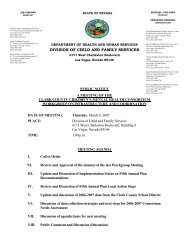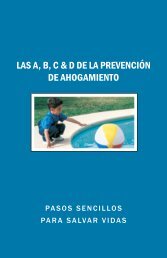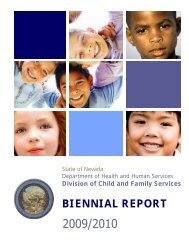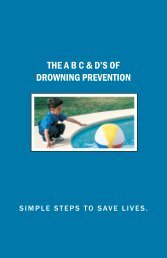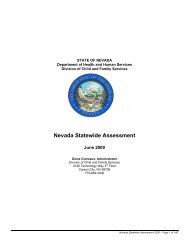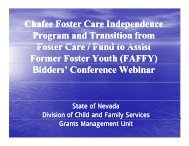STATE OF NEVADA - Division of Child and Family Services
STATE OF NEVADA - Division of Child and Family Services
STATE OF NEVADA - Division of Child and Family Services
You also want an ePaper? Increase the reach of your titles
YUMPU automatically turns print PDFs into web optimized ePapers that Google loves.
Relatives who care for their kin typically receive funds from the State in two ways. They become licensed foster care<br />
providers <strong>and</strong> receive payment through the States’ child protective services agency. The State is then reimbursed for<br />
these payments through the Title IV-E program. The reimbursement rate for Nevada is 52.6%. Relatives who are unable<br />
to become a licensed relative foster family or who care for a child who has not gone through <strong>Child</strong> Protective <strong>Services</strong><br />
(CPS) can receive a TANF child-only grant from the state’s welfare agency. The State has continued to see a rise in the<br />
number <strong>of</strong> children placed with relatives, therefore the ability to support relatives financially while achieving permanency<br />
for children is something Nevada has been exploring through programs for relative <strong>and</strong> kinship care while establishing<br />
feasibility with our current budget crisis.<br />
To assist relatives who care for children in out-<strong>of</strong>-home placements, Nevada has a Non-Needy Relative Caregiver Kinship<br />
Care Program. The <strong>Division</strong> <strong>of</strong> Welfare <strong>and</strong> Supportive <strong>Services</strong> currently administers the Kinship Care Program which<br />
went into effect on October 1, 2001. Since that time children living with a relative Non-Needy Caretaker (NNCT) may<br />
receive a Temporary Assistance for Needy Families (TANF) payment allowance which is a percentage <strong>of</strong> the State <strong>of</strong><br />
Nevada foster care rate. NNCT is defined as relative caretakers who are not requesting assistance for themselves. In<br />
order for a relative caretaker to be eligible for this program they must be 62 or older; be a non-parent; be a non-needy<br />
caretaker; be caring for the child who is related (up to the 5 th degree as described in the <strong>Division</strong> <strong>of</strong> Welfare <strong>and</strong><br />
Supportive <strong>Services</strong> Eligibility <strong>and</strong> Payment Manual) by blood, adoption or marriage for at least six months; file for Nevada<br />
court approval <strong>of</strong> legal guardianship; comply with court imposed requirements; relative household members must have<br />
combined income below 275% <strong>of</strong> the federal poverty level; <strong>and</strong> the child must meet the age, citizenship <strong>and</strong> resource<br />
eligibility requirements. There is an exception to the age requirement due to undue hardship <strong>and</strong> a wavier can be provided<br />
under certain circumstances. According to the Eligibility <strong>and</strong> Payments Manual provided by the <strong>Division</strong> <strong>of</strong> Welfare <strong>and</strong><br />
Supportive <strong>Services</strong> (04/09), current payment rates for the Kinship Care Programs are $534.00 per month for each child,<br />
age 12 years <strong>and</strong> younger; <strong>and</strong>, $616.00 per month for each child age 13 <strong>and</strong> older. The Kinship Care Program also<br />
makes available certain other services such as legal assistance to obtain guardianship, child care, transportation for<br />
certain situations <strong>and</strong> respite care.<br />
In order for Nevada to implement this new option, a statutory change will be necessary, similar to the language included in<br />
statute related to Adoption Subsidies. Nevada is currently conducting a fiscal analysis on this option <strong>and</strong> will be making a<br />
decision by the end <strong>of</strong> August 2010 on whether a bill will be submitted for the 2011 legislative session. The benefit to the<br />
GAP program is that it would allow licensed relatives to move to a guardianship placement <strong>and</strong> still be compensated for<br />
caring for the child. This may be a favored alternative for children who will have no plan <strong>of</strong> reunification or adoption <strong>and</strong><br />
there is a strong bond between the child <strong>and</strong> the relative. This would allow children to move into a permanent placement<br />
rather than remaining in foster care <strong>and</strong> not achieving permanency.<br />
Keeping children with family members sustains their connection to their family roots; usually they are in close proximity to<br />
other relatives, including siblings, which allows them to receive family support that is unavailable or infrequent with non-kin<br />
placements. Additionally, relative foster placements may be beneficial as they may minimize trauma by providing the<br />
child with a sense <strong>of</strong> family support. The impact on Nevada caseloads may decrease due to permanency achievement,<br />
which is an added benefit <strong>of</strong> this program. Figure 09 shows the caseload sizes <strong>of</strong> caseworkers serving children in out-<strong>of</strong>home<br />
care placements from July 1, 2009 through March 31, 2010. The chart shows that despite the fact that relative<br />
placements have become the most prevalent placement type in Nevada; caseloads for workers have remained consistent<br />
over time. The GAP program may assist in decreasing the time a foster child remains on a worker’s caseload.<br />
Nevada APSR – SFY 2010<br />
Page 23 <strong>of</strong> 108



